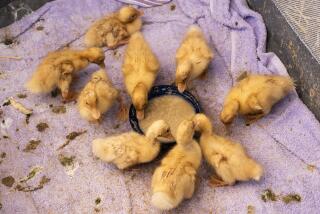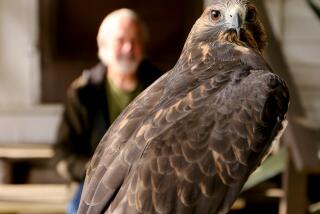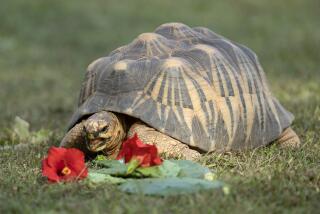A wild goose chase for the goose’s sake
- Share via
They called it a “he” and decided that for today he would be some sort of diving bird — a loon, perhaps, or a grebe.
The “RoboDuck” that wildlife rescuers were chasing around Saturday was actually a humble duck decoy stuck on top of a remote-controlled car that sped around Malibu Bluffs Park as part of a safe-capture drill.
But it symbolized a vexing problem in wildlife rescue: people who find wounded and imperiled animals often have trouble connecting with people who have the knowledge and ability to capture and rehabilitate the animals.
Decades ago, humans faced a comparable problem, said Rebecca Dmytryk, a director of Monterey-based WildRescue. There were few standards for field medicine, or for getting sick or injured people to a hospital. The result: advances in emergency medicine and a seamless network of ambulances.
WildRescue is attempting to create something similar for wildlife.
“The greatest dilemma is linking that ‘finder’ to a specialist who can help — who can rescue it, capture it, give it the care it needs, deliver it to a hospital,” said Dmytryk. “We’re losing wild animals because these skills are not out there.”
The all-volunteer WildRescue, run by Dmytryk and her husband, Duane Titus, held a class Saturday for 20 current and aspiring rescuers. It was the first in a series planned in Southern California, part of a drive to create rescue teams in the next year that would cover a significant portion of the Los Angeles metropolitan area.
Every year, thousands of California animals suffer what are known as anthropogenic injuries — injuries linked to human activity or development. Birds break wings flying into windows; coyotes are hit by cars; nests are destroyed by tree-trimmers; snakes and skunks get snagged in backyard sports netting.
Students gasped when the instructors showed slides and videos of seals caught in fishing tackle, a seagull impaled by a crossbow dart and pelicans with trash stuck around their necks, like a collar.
They learned methods for safe transport, techniques for guarding against dangerous animals, and housing and equipment needs — nets, pillowcases, even pyrotechnics.
The students also learned tips from the wild: After rehab, some animals, such as young deer, can be shunned upon their return if they are tainted with what instructors called “man stink.” Not so for most birds, which can’t smell. Trapping pelicans is fairly simple; they’ll fall for the same trick every time. Savvy seagulls will be on to you quickly.
For many, though, the highlight was chasing RoboDuck, drawing curious stares from soccer players and kite-flyers. Instructors told students they had to capture RoboDuck with nets before he reached the sidewalk — the “water.” After that, he was a goner.
It was tricky business; success was met with enthusiastic applause.
“You get the entire picture of what you’re in for,” said Serena Reid, a volunteer at a Woodland Hills animal shelter. “And there is a lot.”
More to Read
Sign up for Essential California
The most important California stories and recommendations in your inbox every morning.
You may occasionally receive promotional content from the Los Angeles Times.











